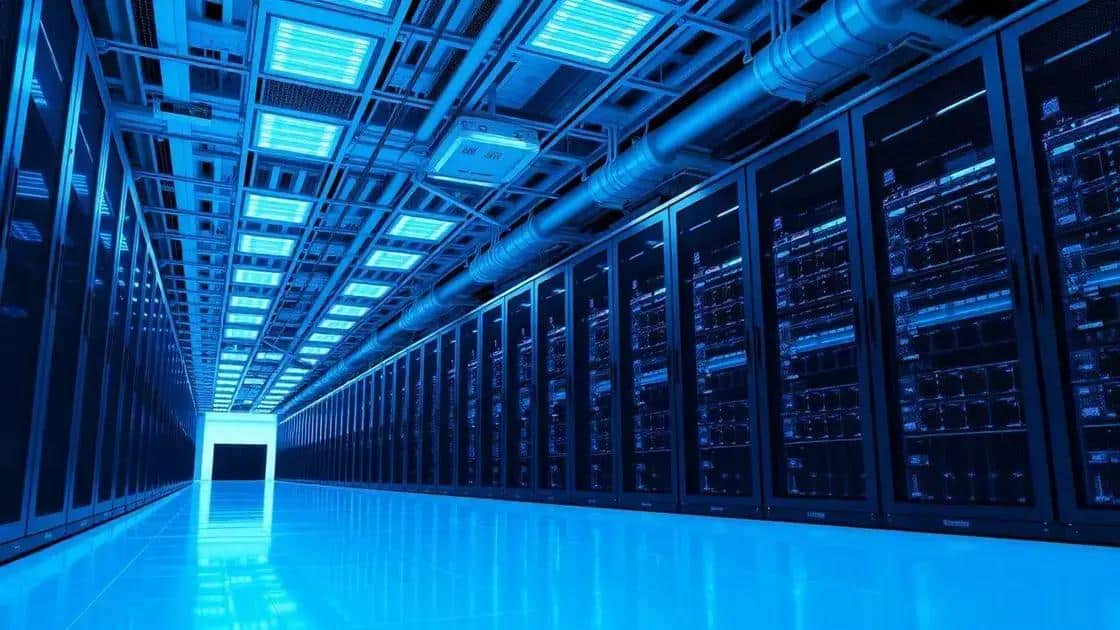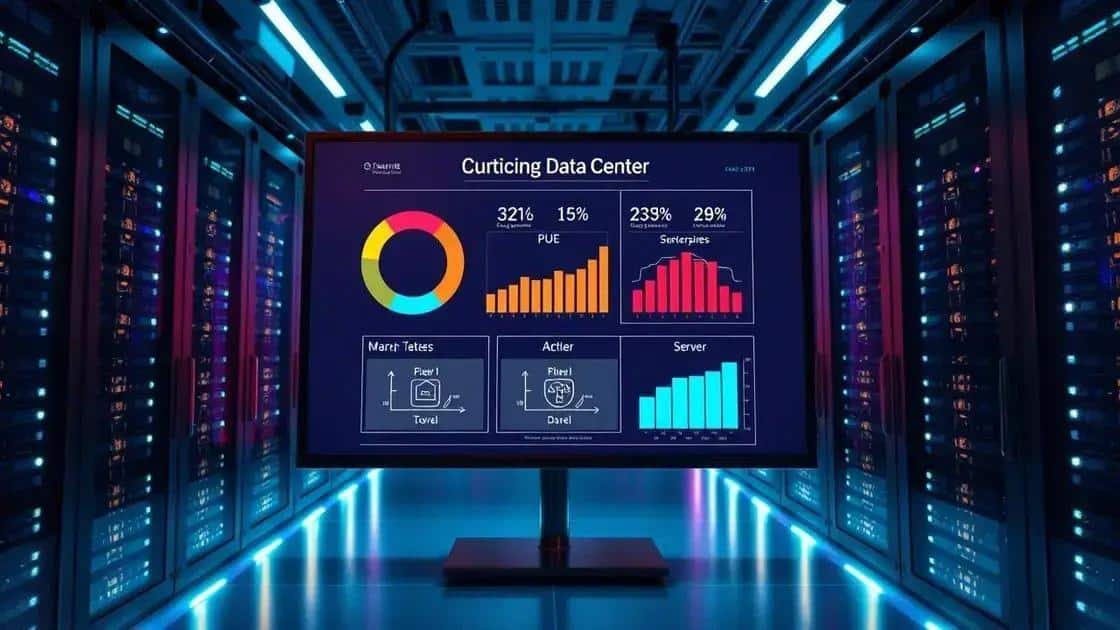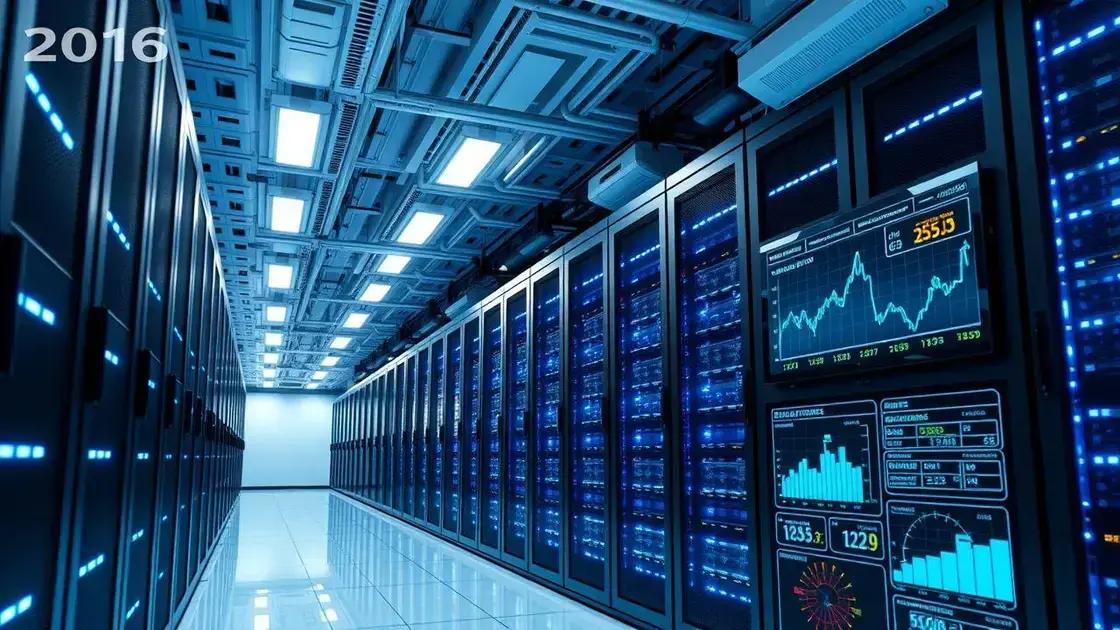Insights on data center efficiency news: what you need

Optimizing data center efficiency involves leveraging key metrics, technology innovations, and best practices to enhance performance, reduce costs, and promote sustainability.
Insights on data center efficiency news are crucial for organizations aiming to enhance their operational performance. Have you considered how these updates can reshape your strategies and drive success? Let’s dive into the latest trends.
Understanding data center efficiency
Understanding data center efficiency is essential for organizations striving to optimize their operations. Efficiency in data centers not only reduces costs but also improves overall performance.
To grasp the concept better, let’s break it down into key components that contribute to efficiency.
Key Components of Data Center Efficiency
Three critical factors play a significant role in determining data center efficiency.
- Power Usage Effectiveness (PUE): This metric evaluates how efficiently a data center uses energy, particularly in cooling and lighting.
- Cooling Optimization: Proper cooling techniques and technologies can minimize energy waste while maintaining optimal operating temperatures.
- Server Utilization: Higher server utilization rates lead to better resource allocation and overall efficiency.
Additionally, data center efficiency can be enhanced through technological innovations. For example, using virtualization can significantly lower the number of physical servers needed. This not only reduces hardware costs but also lessens energy consumption.
It’s also vital to consider sustainability when discussing efficiency. Implementing green practices, such as utilizing renewable energy sources, can reduce a data center’s carbon footprint.
Incorporating automation into operations has proven advantageous as well. By automating routine tasks, companies can lessen human error and free up resources for more essential functions. This leads to an overall increase in efficiency.
Key metrics for measuring efficiency

To understand how to improve data center efficiency, it’s important to focus on specific metrics that can provide insights into performance and resource usage. Knowing these metrics helps organizations set benchmarks for success.
One of the most crucial measurements is Power Usage Effectiveness (PUE). This ratio is calculated by dividing the total energy consumed by the facility by the energy consumed by the IT equipment alone. A lower PUE indicates higher efficiency.
Additional Key Metrics
Several other metrics can enhance the evaluation of a data center’s efficiency:
- Carbon Usage Effectiveness (CUE): Measures the carbon emissions produced per unit of energy consumed.
- Data Center Infrastructure Efficiency (DCIE): Represents the percentage of energy used by the IT equipment compared to total energy use.
- Server Utilization Rate: Shows how effectively servers are being used. Higher rates indicate better resource management.
Understanding these metrics enables businesses to take actionable steps toward improvement. For instance, if high PUE values are identified, organizations should investigate cooling systems or server configurations that may be contributing to excess energy consumption.
Moreover, regular monitoring of these metrics allows for timely adjustments in operational strategies. For example, by analyzing server utilization rates, companies can decide when to scale resources up or down based on actual usage patterns.
Technology innovations driving efficiency
Technology innovations driving efficiency are reshaping the landscape of data centers. These advancements help organizations minimize costs and maximize performance.
One significant innovation is the use of artificial intelligence (AI). AI systems can analyze vast amounts of data to optimize workloads and improve resource allocation. This means that not only can companies save on energy costs but also enhance the overall speed and reliability of their operations.
Advanced Cooling Solutions
Another critical area is in cooling technologies. Innovations such as liquid cooling and evaporative cooling are becoming more popular. These systems use less energy than traditional air conditioning methods, leading to significant energy savings.
- Liquid Cooling: Involves circulating a coolant to absorb heat directly from servers.
- Evaporative Cooling: Utilizes water evaporation for cooling, promoting energy savings.
- Free Cooling: Uses outside air for cooling whenever possible, reducing reliance on mechanical systems.
Alongside cooling technologies, virtualization is another key driver of efficiency. Businesses can run multiple virtual machines on a single physical machine, allowing for better resource utilization. This not only reduces hardware costs but also lessens energy consumption.
Additionally, cloud computing has transformed how data centers operate. By leveraging the cloud, organizations can scale resources up or down based on demand, leading to more efficient resource use. This flexibility means companies are less likely to over-provision resources, ultimately improving efficiency.
Best practices for optimizing data centers

Implementing the best practices for optimizing data centers can greatly enhance their efficiency. By focusing on key strategies, organizations can improve performance while saving costs.
One essential practice is ensuring effective temperature management. Maintaining optimal temperatures is crucial for equipment longevity and performance. Hot aisle and cold aisle containment strategies can help manage airflow, leading to reduced cooling costs.
Energy Efficiency Measures
Energy efficiency is a significant focus area. Companies can reduce energy usage by using energy-efficient hardware and components. This includes investing in servers that meet energy star ratings and using power distribution units that optimize energy consumption.
- Regular Maintenance: Routine checks help ensure all equipment functions correctly and efficiently.
- Virtualization: Reducing the number of physical servers through virtualization maximizes resource use and minimizes energy consumption.
- Renewable Energy: Utilizing renewable energy sources, such as solar or wind, can significantly reduce a data center’s carbon footprint.
In addition to energy measures, implementing proper monitoring tools is vital. Monitoring systems help track performance metrics in real-time, allowing for immediate adjustments and decision-making. This proactive approach helps identify issues before they escalate, maintaining efficiency.
Staff training is another important aspect of optimization. Ensuring that staff are well-trained in best practices and the latest technologies can contribute to a more efficient operation. When employees are knowledgeable, they can make better decisions that enhance performance.
FAQ – Frequently Asked Questions about Data Center Optimization
What are the key metrics for measuring data center efficiency?
Key metrics include Power Usage Effectiveness (PUE), Carbon Usage Effectiveness (CUE), and server utilization rates, which help evaluate performance.
How can AI improve data center operations?
AI can analyze data to optimize resource allocation, predict potential issues, and enhance overall system performance.
What role does cooling technology play in data center efficiency?
Advanced cooling technologies, such as liquid cooling and evaporative cooling, significantly reduce energy consumption and costs.
Why is staff training important for data center management?
Well-trained staff can implement best practices, effectively use technology, and make better decisions to maintain peak efficiency.





